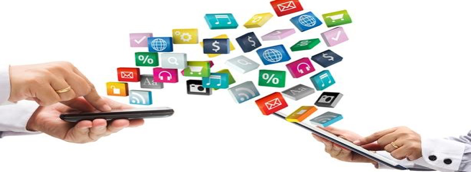The Pillars of Sales Transformation
In November 2013 International Data Corporation (IDC) published a seminal article entitled “The 3rd Platform: Enabling Digital Transformation.” This white paper explored the confluence of four transformational technologies that serve as the foundation for the 3rd platform: cloud computing, social, Big Data and mobile.
IDC pointed out that we have moved from a world populated by hundreds of millions of on-line users relying on tens of thousands of apps to billions of on-line users employing millions of apps. It is easy to be dismissive, overly cautious or even paralyzed by the speed and scope of change. Many would argue that this is an IT issue so the challenges should be left to the hardware, software and application developers.
The reality is that this is a quantum change and an optic into our future. These forces are changing how we know what we know, how we learn and relate as sellers and users, the speed and methods by which business and personal decisions are made and the standards and expectations for our own performance.
For sales executives, there are no “time outs,” “passes,” or “mulligans.” We are living the 3rd platform. The imperative is today. The challenge isn’t to adapt—it’s to provide the leadership and planning necessary to embrace these transformational technologies and succeed.
Let’s take three small steps. First, Let’s put cloud computing aside for the moment. While it is a powerful technology that changes how data is stored, retrieved and used, it’s a “force multiplier” for the technologies referenced above. Second, consider how these three pillars translate into the arena of sales. Third, identify the challenges facing sales executives.
- Social becomes “social selling.”
- Big Data becomes “sales and customer analytics.”
- Mobile becomes “mobile learning” and “on-demand access.”
Social Selling
 Social selling is all about customer intimacy and our ability to personalize and customize messages. It’s less about having a network of 500+ on LinkedIn than knowing how to use a network quickly and effectively to connect with a customer or prospect. It involves:
Social selling is all about customer intimacy and our ability to personalize and customize messages. It’s less about having a network of 500+ on LinkedIn than knowing how to use a network quickly and effectively to connect with a customer or prospect. It involves:
- Leveraging a social network to build customer awareness & trust;
- Tracking people and companies to access sales-relevant information that supports customer intimacy and the buy-sell process; and
- Uses social tools to tell powerful and compelling stories that attract and engage existing or potential customers.
A ForbesBrandVoice contributor shared a simple definition, “To me social selling is the process of helping social buyers become a customer.”
How does a sales executive position the sales force to take maximum advantage of social selling tools?
- Plan to use social selling tools to enhance lead generation.
- Promote use of social selling tools to personalize and customize messages.
- Coach sales personnel to cultivate customer intimacy in business connections by conveying insight.
- Aggregate and share best practices.
- Use social media to identify decision makers.
The last bullet is particularly interesting. Sales representatives who make (49%) or exceed (52%) quota, leverage social media to identify decision makers according to CSO Insights in their 2016 Sales Behaviors Study Trends Analysis.
Executives should remember that social selling is an on-going process that requires a personal investment by sellers each day. It doesn’t substitute for face-to-face communication–it supports it.
Sales & Customer Analytics
 What does sales and customer analytics involve? It ranges from building predictive models to trend and gap analysis. In all sales enterprises, funnel accuracy and management are critical. Sales analytics provides a basis for executives and sellers to establish priorities, allocate resources and coach responsible actions.
What does sales and customer analytics involve? It ranges from building predictive models to trend and gap analysis. In all sales enterprises, funnel accuracy and management are critical. Sales analytics provides a basis for executives and sellers to establish priorities, allocate resources and coach responsible actions.
Each sales executive should develop a plan around the collection and use of sales and customer analytics. They should ask how they can gain accurate and actionable analytics surrounding the buy-sell process? Sales executive should consider actions to:
- Develop predictive models that allow them to forecast success and guide sellers in establishing priorities, forging timelines and making decisions.
- Create a detailed and accurate profile of the customer’s buying process.
- Provide trend and gap analyses that size improvement and change over time.
- Document the link between behavior and success in winning sales opportunities.
Mobile Learning & On-Demand Access
 Mobile learning (mlearning) offers an option to traditional learning that requires time-out-of-field training. Sales executives who have employed mlearning modules cite several compelling advantages.
Mobile learning (mlearning) offers an option to traditional learning that requires time-out-of-field training. Sales executives who have employed mlearning modules cite several compelling advantages.
- Use of “bite-size” learning that is easily accessed and consumed by sellers.
- Ease in updating and customizing learning experiences.
- Just-in-time access to learning as sellers are planning a call or presentation.
- Ease in coaching individual sellers.
Sales Executives Should Consider How To:
- Determine key learning experiences that benefit sellers in customer-facing conversations and address them with customized modules.
- Identify best practices that sellers can easily consume in the field.
- Develop mlearning modules that address on-boarding challenges for new sellers.
- Design a format that supports distance coaching with sellers.
Mobile learning should be viewed as an addition to traditional facilitator led learning and not a replacement.
Parting Thoughts
A new competency has surfaced in the skill set of highly effective sales executives: change management. Each of us is being challenged to harness this trio of forces—social selling, sales analytics and mlearning–to create customer benefits while empowering our front line sellers. Where are you in making this a weapon for your organization?


